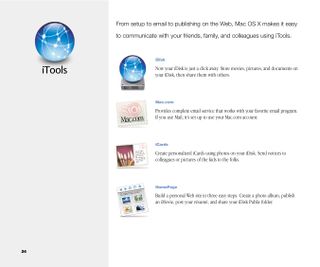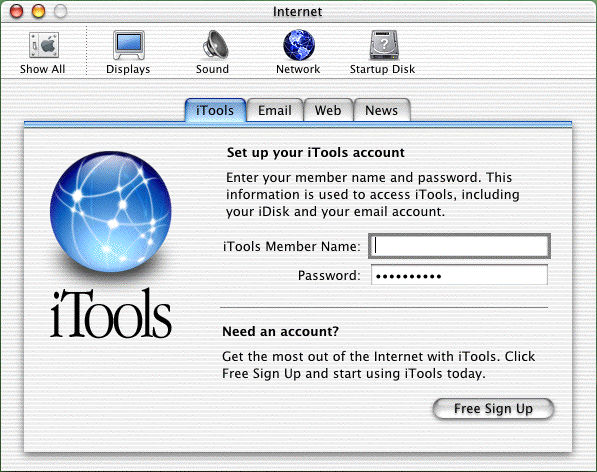Meet iCloud's great-grandfather: iTools

In the beginning — 1994, to be exact — there was eWorld. It was weird, expensive, and poorly marketed. To no one's surprise, it went away.
Six years later, there was iTools. iTools begat .Mac; .Mac begat MobileMe — and a lot of yelling; MobileMe begat iCloud.
The genealogy is a little sparse on worldly details, I'll admit: eWorld was released at a time when the Mac was sagging, and it used AOL's technology to get off the ground. In contrast, by the time iTools was announced — (at the same keynote as the debut of the Aqua interface at Macworld 2000 — Apple had some major Internet technologies of its own in play:
- QuickTime 4 with Internet streaming
- Mac OS 9 with Sherlock 2 and Internet-ready features like keychains and multiple users
- Apple.com was seeing 9.5 million visitors a week
- Apple's online store was doing $1 billion worth of business a year — with the storefront using the company's WebObjects technology.
Macworld 2000 also marked the introduction of a new tabbed design to Apple's website, making the site easier to use and navigate.
The redesign highlighted three new pillars in Apple's Internet strategy: iReview, iCards, and iTools.
iReview
iReview housed reviews and rankings of other websites. Initial reviews were written by Apple employees, and the site launched with 250 published reviews. That number grew slowly, as personal Mac users could append to existing reviews, but not create new ones.
"We're going to do to website reviews," Steve Jobs said, "as Amazon has done for CDs and books."
Master your iPhone in minutes
iMore offers spot-on advice and guidance from our team of experts, with decades of Apple device experience to lean on. Learn more with iMore!
iReview was pitched as a trusted advisor for people exploring the Internet, but it was short-lived. Apple shuttered the site in February 2001 due to low interest.
iCards
Apple also introduced iCards, a section of the company's website where users could go to create and send virtual greeting cards.
Arguably, Apple's cards were better-looking and classier than those offered by other greeting card sites at the time. That likely contributed to iCards's eight-year run — the page was shuttered in 2008 with the release of MobileMe.
Digital cards were nice, but the ability to create fully-custom digital and physical cards (and other stationary) within iPhoto and Aperture — and later, Photos and the now-discontinued Cards for iOS) app — ultimately doomed the website.
iTools
While in hindsight, iReview and iCards may not have been long-term winners, the final piece of Apple's 2000-era puzzle built the foundation for Apple's modern Internet applications suite.
During iTools's introduction, Jobs discussed that owning both the client OS and the server-side components allowed Apple to create an "entirely new class of Internet services" exclusively for Mac users, free of charge.
iTools was made up of four "revolutionary" products, as shown on this page from OS X's welcome guide:

KidSafe
Touted as a "breakthrough approach" to protect kids on the Internet, KidSafe wasn't an Internet filter; instead, it was a directory of family-friendly websites.
The former, Jobs said, just couldn't keep up with the rapid growth of the Internet. KidSafe was a whitelist of approved sites, rather than an incomplete filter of material that shouldn't be seen by children. It launched with 50,000 websites its directory, all approved by teachers and librarians.
In August 2001, Apple shuttered KidSafe, pointing parents to other sources help keep their kids safe online. However, OS X's Parental Controls system still allows for a whitelist of sites to be used in order to limit kids' browsing:

Mac.com email
With iTools, users could sign up for email addresses at @mac.com. The Apple-run email service provided users with features like auto-reply and auto-forward.
The original mac.com email system didn't have any webmail; users had to configure their email clients to talk to the system over POP.
Mac.com email addresses later became me.com in the MobileMe age, before being replaced with icloud.com. Though you can no longer acquire a new mac.com or me.com address, you can spot early iTools users by their mac.com aliases, which are still active and useable.
iDisk
iDisk offered users 20MB (yes, MB!) of Internet storage, hosted on Apple's servers. Instead of fiddling with FTP settings, iDisk was baked into Mac OS 9 — there was an icon for it right on the Desktop.
iDisk worked like a regular folder on the system; dragging files in to or out of iDisk would copy them to or from the server. And files in the Public directory were easily shared with other iTools users.
Starting in July 2000, Apple allowed users to purchase up to 400 extra megabytes at a yearly rate of a $1 per megabyte.
While features like the local syncing of files were a few years away, out of all the Internet technologies introduced during Macworld 2000, iDisk perhaps is the most important historically.
Here's part of Kyle D'Addario's reaction after some hands-on time 16 years ago:
This truly is the next level of drag and drop. Mac Observer staff members tested iDisk yesterday evening by sending Macworld [Expo] related files back and forth to each other. The process of storing files in one Public folder, and having those files accessed and saved by somebody else took less than two minutes. Standard Mac OS copy progress bars keep the user aware of the status of the file. iDisk has brought file sharing to the masses. We have heard for years that operating system designers have wanted to seamlessly integrate the Internet with the desktop environment. Sherlock was the first step in that direction, iDisk has finished the job.
If that sounds familiar, it's because Internet-based file sharing is now ubiquitous — thanks not only to Apple, but to companies like Dropbox and Box as well.
HomePage
The final piece of the iTools package was HomePage, an online program that let users build custom websites without needing to code. HomePage used iDisk as a shuttle for local content like photo albums, movies and more.
Building out a site was as simple as picking a theme, selecting content from iDisk and hitting the publish button. Even in 2016, creating a website isn't that simple for most people.
iTools' legacy
In addition to all of the tech that iTools presented, it brought to life a new partnership. Apple invested in EarthLink, to bring the ISP's service to Mac users in a concise way. However, the technology is the big story here. While iTools was launched at the end of the iOS 9 era, it also made the transition to OS X.

While its easy to focus on the OS X transition when thinking about this timeframe in Apple's history, I believe that the company's Internet strategy was vitally important, as well. Mac OS 9 brought a lot of Internet-based tools to the Mac in a new way, while the hardware made it easier than ever to connect.
Of course, like all things, this strategy changed quickly. In July 2002, the much more modern .Mac replaced iTools, offering IMAP and webmail, additional iDisk space and a much improved HomePage, but those upgrades didn't come without cost: .Mac was $99/year, as was MobileMe in 2008.
While many things from Apple's 2000-era Internet strategy haven't made the journey to the present, much of the core ideals persist. With iCloud, Apple has once again reverted to the free-with-paid-storage-upgrades model. And iCloud offers webmail, cloud storage and deep integration with Apple's operating systems, just like its predecessor introduced 16 years ago.
As for reliability, well... that's another story for another day.
Stephen Hackett is the co-founder of the Relay FM podcast network. He's written about Apple for seven years at 512 Pixels, and has more vintage Macs than family members living in his Memphis, TN home.
